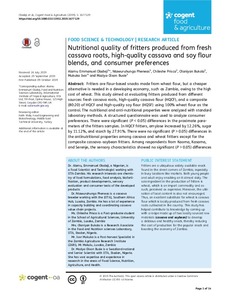| dc.contributor.author | Alamu, E.O. |
| dc.contributor.author | Ntawuruhunga, P. |
| dc.contributor.author | Chileshe, P. |
| dc.contributor.author | Olaniyan, B. |
| dc.contributor.author | Mukuka, I. |
| dc.contributor.author | Maziya-Dixon, B. |
| dc.date.accessioned | 2019-12-04T11:37:24Z |
| dc.date.available | 2019-12-04T11:37:24Z |
| dc.date.issued | 2019 |
| dc.identifier.citation | Alamu, E.O., Ntawuruhunga, P., Chileshe, P., Olaniyan, B., Mukuka, I. & Maziya-Dixon, B. (2019). Nutritional quality of fritters produced from fresh cassava roots, high-quality cassava and soy flour blends, and consumer preferences. Cogent Food & Agriculture, 5, 1-14. |
| dc.identifier.issn | 2331-1932 |
| dc.identifier.uri | https://hdl.handle.net/20.500.12478/6505 |
| dc.description | Open Access Journal; Published online: 09 Oct 2019 |
| dc.description.abstract | Fritters are flour-based snacks made from wheat flour, but a cheaper alternative is needed in a developing economy, such as Zambia, owing to the high cost of wheat. This study aimed at evaluating fritters produced from different sources: fresh cassava roots, high-quality cassava flour (HQCF), and a composite (80:20) of HQCF and high-quality soy flour (HQSF) using 100% wheat flour as the control. The nutritional and anti-nutritional properties were analyzed with standard laboratory methods. A structured questionnaire was used to analyze consumer preferences. There were significant (P < 0.05) differences in the proximate parameters of the fritters samples. In HQCF fritters, amylose increased by 12.26%, sugar by 11.12%, and starch by 27.91%. There were no significant (P > 0.05) differences in the antinutritional properties among cassava and wheat fritters except for the composite cassava‒soybean fritters. Among respondents from Kaoma, Kasama, and Serenje, the sensory characteristics showed no significant (P > 0.05) differences for appearance and aroma of all the fritters samples. The results showed that HQCF fortified with HQSF could be used as a cheaper alternative to wheat flour in the production of nutritious and acceptable fritters. |
| dc.format.extent | 1-14 |
| dc.language.iso | en |
| dc.rights | CC-BY-4.0 |
| dc.subject | Cassava |
| dc.subject | Flours |
| dc.subject | Wheats |
| dc.subject | Food Production |
| dc.subject | Food Security |
| dc.subject | Processing |
| dc.subject | Soybeans |
| dc.title | Nutritional quality of fritters produced from fresh cassava roots, high-quality cassava and soy flour blends, and consumer preferences |
| dc.type | Journal Article |
| dc.description.version | Peer Review |
| cg.contributor.crp | Agriculture for Nutrition and Health |
| cg.contributor.crp | Maize |
| cg.contributor.crp | Roots, Tubers and Bananas |
| cg.contributor.affiliation | International Institute of Tropical Agriculture |
| cg.contributor.affiliation | University of Zambia |
| cg.contributor.affiliation | Zambia Agricultural Research Institute |
| cg.coverage.region | Africa |
| cg.coverage.region | Southern Africa |
| cg.coverage.country | Zambia |
| cg.creator.identifier | Alamu Emmanuel Oladeji: 0000-0001-6263-1359 |
| cg.creator.identifier | Pheneas Ntawuruhunga: 0000-0003-2330-9070 |
| cg.researchtheme | NATURAL RESOURCE MANAGEMENT |
| cg.researchtheme | NUTRITION & HUMAN HEALTH |
| cg.isijournal | ISI Journal |
| cg.authorship.types | CGIAR and developing country institute |
| cg.iitasubject | Cassava |
| cg.iitasubject | Food Science |
| cg.iitasubject | Food Security |
| cg.iitasubject | Food Systems |
| cg.iitasubject | Grain Legumes |
| cg.iitasubject | Nutrition |
| cg.iitasubject | Soybean |
| cg.journal | Cogent Food & Agriculture |
| cg.howpublished | Formally Published |
| cg.accessibilitystatus | Open Access |
| local.dspaceid | 108267 |
| cg.targetaudience | Scientists |
| cg.identifier.doi | https://dx.doi.org/10.1080/23311932.2019.1677129 |

